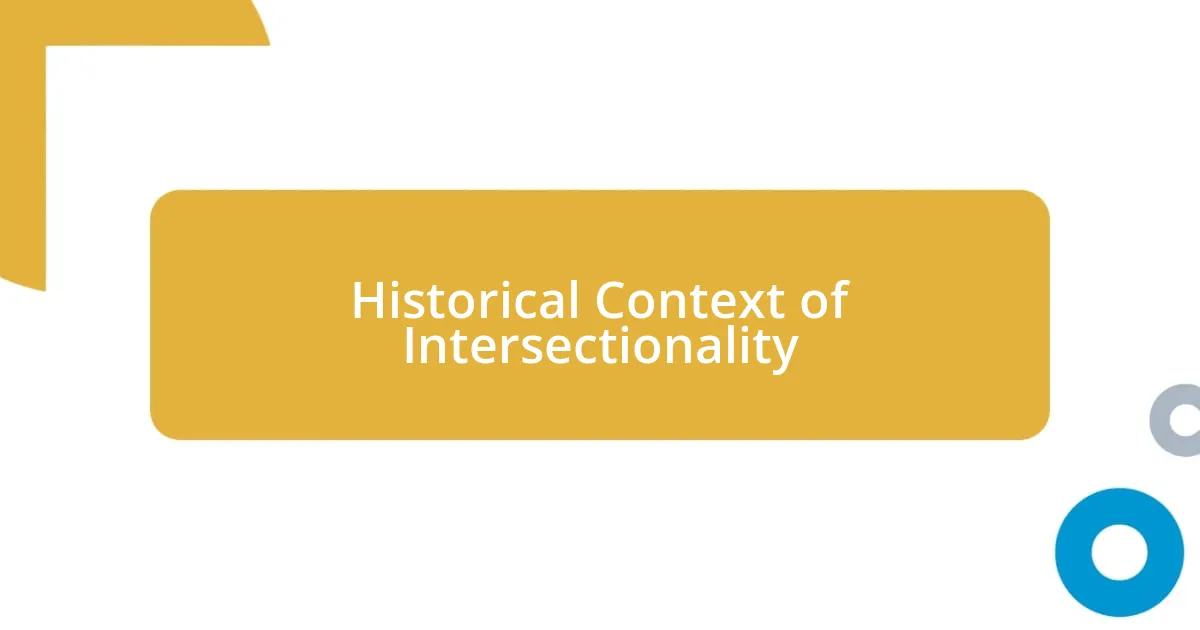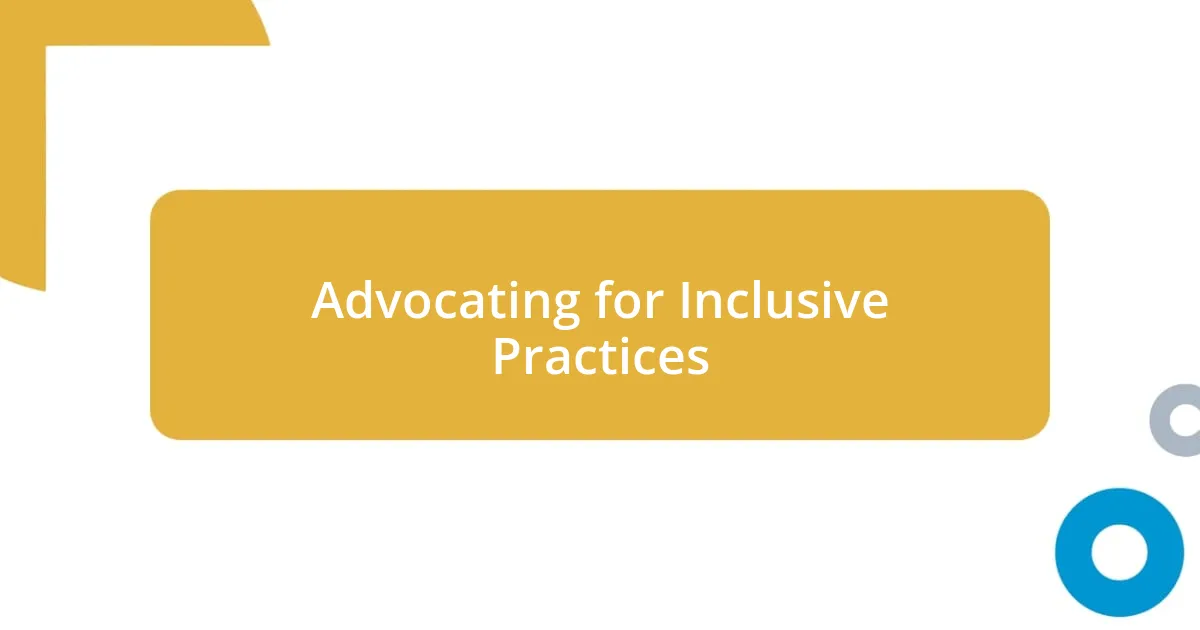Key takeaways:
- The term “intersectionality” was coined by Kimberlé Crenshaw in 1989, highlighting the overlapping experiences of oppression faced by women of color and influencing movements across social dynamics.
- Personal experiences, such as growing up in a mixed-race household, shape one’s understanding of intersectionality, emphasizing its relevance in daily life interactions and fostering empathy towards others.
- Advocacy for inclusive practices must go beyond representation, focusing on actively uplifting diverse voices and understanding the nuances of individual stories to create safe spaces and genuine engagement.
- Understanding intersectionality is an ongoing journey that requires humility, openness, and a commitment to amplifying the voices of those whose experiences differ from our own.

Understanding the Basics of Intersectionality
Intersectionality is essentially about how different aspects of a person’s identity—like race, gender, sexuality, and class—interact and shape their experiences in society. When I first heard about intersectionality, I was surprised at how many layers there are to each person’s experience. It made me reflect: how often do we consider the multiple identities someone carries, and how they impact their interaction with the world?
For example, I recall a friend who navigated her life as a Black woman in a predominantly white workplace. She often struggled not just against racial bias, but also faced challenges tied to her gender. Each facet of her identity contributed to a unique set of obstacles. This made me realize that understanding intersectionality requires us to dig deeper and look beyond the conventional categories of identity.
It’s also important to remember that intersectionality isn’t just academic; it’s deeply personal. Have you ever felt the weight of your own multiple identities? I have, and it’s a whirlwind of emotions. It can be empowering to embrace the complexity of who we are, but it can also be overwhelming. This dynamic interplay gives each of us a distinct perspective, shaping not just our experiences but also how we relate to others.

Historical Context of Intersectionality
The historical context of intersectionality is rooted in social movements that sought to address the interconnected nature of oppression. Early advocates like Kimberlé Crenshaw, who coined the term in the late 1980s, highlighted how traditional feminist movements often overlooked the experiences of women of color. I remember stumbling across Crenshaw’s work during my studies and feeling an ‘aha’ moment—her insights clarified experiences I had witnessed in my community, where overlapping identities influenced how individuals faced discrimination.
- The term “intersectionality” was first introduced in 1989 by Kimberlé Crenshaw in her paper discussing the legal dilemma of Black women.
- The Combahee River Collective, a group of Black feminists in the 1970s, emphasized the importance of race, gender, and class in their struggles.
- In the 1990s, intersectionality became a framework for understanding multiple forms of identity and social dynamics within critical race theory.
- Movements like the LGBTQ+ rights movement also contributed to expanding the conversation around multiple identities and intersecting oppressions.
I find it fascinating how historical context illuminates the complexity of our social frameworks. Reflecting on these origins fuels my understanding of today’s conversations around identity, making me more mindful of acknowledging diverse perspectives in my daily interactions.

Personal Experiences Shaping My Perspective
My journey to understanding intersectionality has been deeply shaped by my own experiences of identity. Growing up in a mixed-race household, I often felt like I was straddling two worlds—one where my racial background was a source of pride, and another where it drew unwanted attention. This constant negotiation of my identity helped me see firsthand how different social forces can impact daily life. It’s not just about the color of my skin; it’s also about my gender, my socioeconomic status, and how they blend into my personal narrative.
A defining moment for me was when I volunteered at a local organization serving marginalized communities. Listening to the stories of women who faced multiple layers of oppression stirred something in me. For instance, one woman shared her challenges as a queer immigrant woman, and I could feel her pain and resilience. Each identity she carried shaped her experiences uniquely, reflecting the multiplicity of struggles that exist in our society. It was a powerful reminder of how our lives are not lived in isolation but are influenced by a complex web of social identities.
Reflecting on these personal connections, I’ve come to appreciate how intersectionality is not merely an academic concept but a lived reality for many. It invokes emotions like empathy and realization within me. When I see someone grappling with their intersecting identities, I can’t help but relate. It’s an invitation to engage in conversations that matter and brings to light the often-overlooked nuances of our shared humanity.
| Personal Experience | Emotional Insight |
|---|---|
| Growing up in a mixed-race household | Straddling two worlds can feel isolating yet enlightening. |
| Volunteering with marginalized communities | Realizing the power of personal stories fosters empathy and connection. |

Exploring Key Concepts and Frameworks
When I dive into the key concepts of intersectionality, I can’t help but recall a thought-provoking discussion I had during a seminar. We dissected the importance of understanding how different factors, like race and class, interplay to create distinct experiences of oppression. It dawned on me how crucial it is to remember that every identity layer doesn’t act in isolation; instead, they intersect and influence one another. Have you ever noticed how a simple label can encapsulate a rich tapestry of experiences? This realization guides my approach to social justice and advocacy.
One concept that struck me is the idea of the “matrix of domination,” introduced by scholars who explored how structures of power operate across different social categories. This framework has been invaluable in helping me dissect my own privileges and blind spots. During a community workshop, I remember a participant sharing her narrative about navigating life as a Black, disabled woman. Hearing her recount the challenges of accessing healthcare made me rethink my own experiences with privilege. It’s these moments that reinforce why intersectionality matters; they remind me that dismantling systemic injustices requires us to consider multiple lenses simultaneously.
As I reflect on these frameworks, I find that they resonate deeply within me. Each concept brings awareness to my interactions and challenges me to question my assumptions. For instance, when I witness someone in distress, I ask myself—what identities are shaping their experience here? This approach fosters a rich dialogue about social justice and empathy, reminding me that the intersection of our identities creates a unique pathway through life that deserves recognition and respect.

Intersectionality in Daily Life
When I think about intersectionality in daily life, I immediately recall the café conversations I’ve had with friends representing diverse backgrounds. One time, a friend shared her experience of being a Latina woman in a corporate setting, highlighting how her ethnicity added layers to the challenges she faced in being heard. It made me pause and wonder: how often do we overlook the unique obstacles someone might grapple with that stem from their intersectional identities? These moments of sharing often reveal the profound impact of our social contexts on our everyday interactions.
Another vivid instance comes to mind from my visits to diverse neighborhoods. I remember chatting with a neighbor who is a single mother and a refugee. Her narrative about navigating the healthcare system left me both heartbroken and enlightened. It struck me how her experiences are shaped not just by her status as a mother, but also by her immigration journey and the socioeconomic barriers she faces. Such discussions underscore the importance of understanding how overlapping identities inform the struggles of individuals, inviting deeper empathy from those of us with fewer burdens.
I’ve also noticed subtle intersectional dynamics in my volunteer work at a youth center. One girl, who identifies as both queer and Black, expressed how she feels the weight of additional scrutiny within her community. Listening to her struggles illuminated something powerful for me: the way society sometimes breaks individuals down into isolated identities misses the complexity of their reality. It prompts me to ask myself—when I engage with others, am I considering the full picture of their identity? Every encounter becomes an opportunity for connection and understanding, urging me to embrace the intricacies of our shared human experience.

Advocating for Inclusive Practices
Advocating for inclusive practices requires active listening and genuine engagement with those whose voices have been marginalized. I remember during a recent community event, a panelist shared her experience as a queer woman of color in academia. Hearing her struggle to find mentorship and support made me realize how essential it is to create safe spaces where every individual feels valued. This prompted me to ask myself: how can we ensure that our advocacy doesn’t just mimic the structures of power but instead uplifts diverse voices?
As I reflect on my experiences in advocacy groups, I’ve noticed the tendency to overlook the nuances of individual stories. A dear friend of mine, who identifies as both a Muslim and a disabled person, once expressed frustration over tokenism in discussions about diversity. Her insights made me acknowledge a hard truth: when we advocate for inclusivity, we must focus not just on representation but also on the inclusion of varied perspectives. It encourages me to advocate for practices that go beyond surface-level acknowledgment, pushing for a deeper understanding of identity dynamics.
There’s a transformative power in recognizing our collective responsibility to foster inclusivity. The other day, I participated in a training session about equitable practices. It was enlightening to see how our facilitators incorporated various perspectives, making the dialogue richer and more authentic. It leaves me wondering—when was the last time I actively sought out voices that differ from my own? This question drives me to pursue advocacy that truly embodies intersectionality, where every voice has a seat at the table and every story is honored.

Continuing the Journey of Understanding
Continuing my journey of understanding intersectionality often feels like peeling back layers of an onion. Just the other day, I found myself in a workshop where we explored our own identities. It was striking to hear how a participant, a non-binary person of color, shared profound insights about navigating spaces that felt unwelcoming. This experience made me reflect on my own privilege and the responsibility I have to amplify voices that aren’t always heard. How do our own experiences shape our understanding of others?
I also had an eye-opening experience volunteering at a community garden. While chatting with an elderly woman who identified as a Black immigrant, I was struck by her stories of struggle and resilience through cultural barriers. Her laughter amidst her challenges was infectious, yet it left me pondering: how many moments of joy are overshadowed by systemic hurdles that others face? This encounter underscored the necessity of recognizing how varying identities influence not just struggles but also triumphs.
Each conversation I have marks a stepping stone on this journey. Recently, I attended a lecture on the importance of allyship, and one point resonated deeply with me: the idea that understanding intersectionality is not a destination but a continuous path requiring humility and openness. I found myself questioning, am I genuinely engaging with this journey, or merely skimming the surface? It’s a challenge I embrace, one that urges me to delve deeper into the stories of those around me and foster a space where every facet of identity is acknowledged and celebrated.












